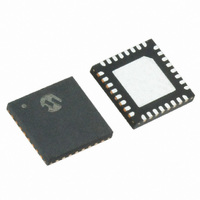MRF89XA-I/MQ Microchip Technology, MRF89XA-I/MQ Datasheet - Page 11

MRF89XA-I/MQ
Manufacturer Part Number
MRF89XA-I/MQ
Description
TXRX ISM SUB-GHZ ULP 32QFN
Manufacturer
Microchip Technology
Specifications of MRF89XA-I/MQ
Package / Case
32-WFQFN Exposed Pad
Frequency
863MHz ~ 870MHz, 902MHz ~ 928MHz, 950MHz ~ 960MHz
Data Rate - Maximum
200kbps
Modulation Or Protocol
FSK, OOK
Applications
ISM
Power - Output
12.5dBm
Sensitivity
-113dBm
Voltage - Supply
2.1 V ~ 3.6 V
Current - Receiving
3mA
Current - Transmitting
25mA
Data Interface
PCB, Surface Mount
Antenna Connector
PCB, Surface Mount
Operating Temperature
-40°C ~ 85°C
Number Of Receivers
1
Number Of Transmitters
1
Wireless Frequency
863 MHz to 870 MHz, 902 MHz to 928 MHz, 950 MHz to 960 MHz
Interface Type
SPI
Noise Figure
- 112 dBc
Output Power
- 8.5 dBm, + 12.5 dBm
Operating Supply Voltage
2.1 V to 3.6 V
Maximum Operating Temperature
+ 85 C
Mounting Style
SMD/SMT
Maximum Data Rate
256 Kbps
Maximum Supply Current
25 mA
Minimum Operating Temperature
- 40 C
Modulation
FSK
Lead Free Status / RoHS Status
Lead free / RoHS Compliant
Memory Size
-
Lead Free Status / Rohs Status
Lead free / RoHS Compliant
Available stocks
Company
Part Number
Manufacturer
Quantity
Price
Company:
Part Number:
MRF89XA-I/MQ
Manufacturer:
MICROCHIP
Quantity:
12 000
2.0
The MRF89XA is an integrated, single chip, low-power
ISM band sub-GHz transceiver. A detailed block
diagram of the MRF89XA is illustrated in Figure 2-1.
The frequency synthesizer is clocked by an external
12.8 MHz crystal, and frequency ranges from 863-870
MHz, 902-928 MHz and 950-960 MHz are possible.
The MRF89XA receiver employs a superheterodyne
architecture. The first IF is one-ninth of the RF
frequency (approximately 100 MHz). The second down
conversion down converts the I and Q signals to
baseband in the case of the FSK receiver (zero-IF) and
to a low-IF (IF2) for the OOK receiver. After the second
down-conversion stage, the received signal is channel
select filtered and amplified to a level adequate for
demodulation. Both FSK and OOK demodulation are
available. Image rejection is achieved by using a SAW
filter.
The baseband I and Q signals at the transmitter side are
digitally generated by a Direct Digital Synthesis (DDS)
whose Digital-to-Analog Converters (DAC) followed by
two anti-aliasing low-pass filters transform the digital
signal into analog In-Phase (I) and Quadrature (Q)
components with frequency as the selected Frequency
Deviation (f
OOK modes of operation. The transmitter has a typical
output power of +12.5 dBm. An internal transmit/receive
switch combines the transmitter and receiver circuits into
a single-ended RFIO pin (pin 31). The RFIO pin is
connected through the impedance matching circuitry to
an external antenna. The device operates in the
low-voltage range of 2.1V to 3.6V, and in Sleep mode, it
operates at a very low-current state, typically 0.1 µA.
© 2010 Microchip Technology Inc.
HARDWARE DESCRIPTION
dev
). The transmitter supports both FSK and
Preliminary
The frequency synthesizer is based on an integer-N
PLL having PLL bandwidth of 15k Hz. Two
programmable frequency dividers in the feedback loop
of the PLL and one programmable divider on the
reference oscillator allow the LO frequency to be
adjusted. The reference frequency is generated by a
crystal oscillator running at 12.8 MHz.
The MRF89XA is controlled by a digital block that
includes registers to store the configuration settings of
the radio. These registers are accessed by a host
microcontroller through a Serial Peripheral Interface
(SPI). The quality of the data is validated using the
RSSI and bit synchronizer blocks built into the
transceiver. Data is buffered in a 64-byte transmitter or
receiver FIFO. The transceiver is controlled through a
4-wire SPI, interrupts (IRQ0 and IRQ1), PLOCK, DATA
and Chip Select pins for SPI are illustrated in
Figure 2-1. On-chip regulators provide stable supply
voltages to sensitive blocks and allow the MRF89XA to
be used with supply voltages from 2.1 to 3.6V. Most
blocks are supplied with a voltage below 1.4V.
The MRF89XA supports the following feature blocks:
• Data Filtering and Whitening
• Bit Synchronization
• 64-byte Transmit/Receive FIFO Buffer
• General Configuration Registers
These features reduce the processing load, which
allows the use of simple, low-cost 8-bit microcontrollers
for data processing.
MRF89XA
DS70622B-page 11












